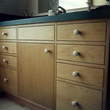Home : 32mm : Styles : Inset Flush :
 With the inset style of cabinets the doors/drawers are inset so that their faces are flush with the face of the box. I remember a Fine Homebuilding article on building inset style cabinets using full overlay boxes and what a lot of extra work and pieces it was. Somewhere along the line it occurred to me that the shared panel construction of half-overlay cabinets was ideal for inset cabinets.
With the inset style of cabinets the doors/drawers are inset so that their faces are flush with the face of the box. I remember a Fine Homebuilding article on building inset style cabinets using full overlay boxes and what a lot of extra work and pieces it was. Somewhere along the line it occurred to me that the shared panel construction of half-overlay cabinets was ideal for inset cabinets.
 For the example drawing I simply reduced the perimeter of the half-overlay faces by 11mm so that they would sit inside the openings and have a 3mm reveal. The only other difference is that the system rows have to be moved from 37mm to ~56mm (37 + face thickness) from the front of the box. As with half-overlay, inset panels can be balanced and system holes can be used as construction holes. Both styles will only work (seamless box face) when shared panels are used. When using the 32mm system, half-overlay and inset cabinets are as close as you can get to a 'perfect' cabinet.
For the example drawing I simply reduced the perimeter of the half-overlay faces by 11mm so that they would sit inside the openings and have a 3mm reveal. The only other difference is that the system rows have to be moved from 37mm to ~56mm (37 + face thickness) from the front of the box. As with half-overlay, inset panels can be balanced and system holes can be used as construction holes. Both styles will only work (seamless box face) when shared panels are used. When using the 32mm system, half-overlay and inset cabinets are as close as you can get to a 'perfect' cabinet.
 ...Here's a railed inset (shifted registration) drawing showing how width and height increments work on railed inset base cabinets with undermount drawers. The table has the relevent color coded entries highlighted (use prev/next to switch back and forth).
...Here's a railed inset (shifted registration) drawing showing how width and height increments work on railed inset base cabinets with undermount drawers. The table has the relevent color coded entries highlighted (use prev/next to switch back and forth).
While the full table (34KB pdf) contains information specific to undermount slides (22.5 BO, e.g. Blum and Hettich) and drawer boxes, the carcase and face height/width increments apply to all railed inset cabinets made with 19mm stock and having 3mm face gaps.
See also: Railed Inset Hinge Placement (all the other information on the Increments page is included in the above pdf)
Railed Inset
 With the inset style of cabinets the doors/drawers are inset so that their faces are flush with the face of the box. I remember a Fine Homebuilding article on building inset style cabinets using full overlay boxes and what a lot of extra work and pieces it was. Somewhere along the line it occurred to me that the shared panel construction of half-overlay cabinets was ideal for inset cabinets.
With the inset style of cabinets the doors/drawers are inset so that their faces are flush with the face of the box. I remember a Fine Homebuilding article on building inset style cabinets using full overlay boxes and what a lot of extra work and pieces it was. Somewhere along the line it occurred to me that the shared panel construction of half-overlay cabinets was ideal for inset cabinets.  For the example drawing I simply reduced the perimeter of the half-overlay faces by 11mm so that they would sit inside the openings and have a 3mm reveal. The only other difference is that the system rows have to be moved from 37mm to ~56mm (37 + face thickness) from the front of the box. As with half-overlay, inset panels can be balanced and system holes can be used as construction holes. Both styles will only work (seamless box face) when shared panels are used. When using the 32mm system, half-overlay and inset cabinets are as close as you can get to a 'perfect' cabinet.
For the example drawing I simply reduced the perimeter of the half-overlay faces by 11mm so that they would sit inside the openings and have a 3mm reveal. The only other difference is that the system rows have to be moved from 37mm to ~56mm (37 + face thickness) from the front of the box. As with half-overlay, inset panels can be balanced and system holes can be used as construction holes. Both styles will only work (seamless box face) when shared panels are used. When using the 32mm system, half-overlay and inset cabinets are as close as you can get to a 'perfect' cabinet. ...Here's a railed inset (shifted registration) drawing showing how width and height increments work on railed inset base cabinets with undermount drawers. The table has the relevent color coded entries highlighted (use prev/next to switch back and forth).
...Here's a railed inset (shifted registration) drawing showing how width and height increments work on railed inset base cabinets with undermount drawers. The table has the relevent color coded entries highlighted (use prev/next to switch back and forth). While the full table (34KB pdf) contains information specific to undermount slides (22.5 BO, e.g. Blum and Hettich) and drawer boxes, the carcase and face height/width increments apply to all railed inset cabinets made with 19mm stock and having 3mm face gaps.
See also: Railed Inset Hinge Placement (all the other information on the Increments page is included in the above pdf)
